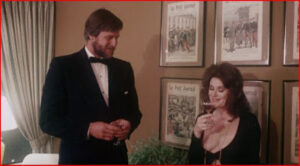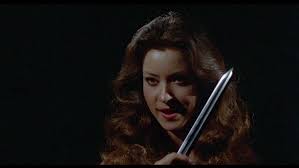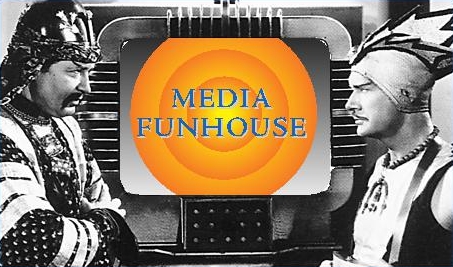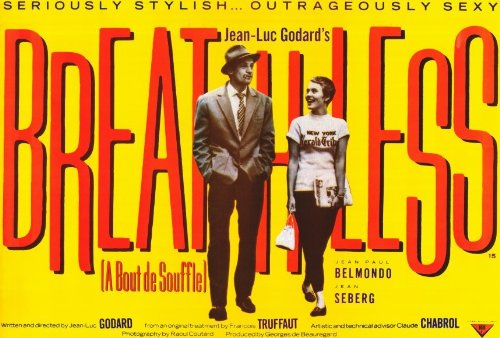Media Funhouse favorites: trash classics in search of a cult
(First published in the Dark Horse Comic “Otis Goes Hollywood” in 1997 under the title “Welcome to Hellywood”; used with the written permission of the author and publication of first instance.)
By Ed Grant
Part One
The concept of “happy pain” always constituted an important part of my friends’ and my viewing habits. Several years ago, using a phrase I’d misremembered from a French sex farce (meaning, in that case, anal sex) I found a way to describe the delirium-like effect produced by watching those movies we loved so dearly, the ones that, to use a more familiar phrase, are “so bad they’re good.” In the years before home video, these were the films we could boast proudly about having paid full price to see in a theater. It was great, all right, to see a good movie, but there was a special thrill to be had from encountering one of these rotten gems.
By the mid to late 1980s, everyone in my immediate, film-crazed circle had a VCR, and then the fun really began. It was now possible to scan the shelves of our local video stores and come out with the dregs: films that had bypassed our local theaters, or which had played but under a different title (the cheapest tease of all to a seasoned cinephile). Soon video-night get-togethers would accompany each new discovery–good friends from out of state would be sure to dupe their own trash-classic finds and ship ’em on to be enjoyed by other groups of stunned and amazed viewers.
Currently, it is possible to own original copies of these undiscovered camp fests. While local Mom and Pop stores (bless their hearts) have kept their inventory mostly intact, the larger, demonic chain stores have consecrated entire aisles to “sell-through” or “previously viewed” titles (many cities have entire stores or warehouses featuring such product). It is on those shelves that you can find the following (mostly out of print) items. They are all jaw-droppingly weird, bizarrely imaginative, and 100% misguided. The old video-night rule is still in place: no fast-forwarding allowed (the pure joy of a movie’s absurd scenes can only resound after one has endured the tedious sequences that preceded them). And always remember–“happy pain” is best endured in the company of friends.
 Lady Streetfighter (1987 video release; Unicorn HV. Out of print) Now that a small but fervent cult has been developing around the work of exploitation director Doris Wishman, I would like to tout another female filmmaker in major need of rediscovery: actress/screenwriter/director Renee Harmon. I’ve only seen two of Harmon’s productions, but, judging from them and her unique performance as the Wicked Stepmother in Al Adamson’s mind-roastingly weird sci-fi sex musical Cinderella 2000, I can honestly state that Ms. Harmon is someone to be reckoned with (she also wasn’t too particular about the spelling of her name–I’ve seen it on-screen as “Rena,” “Renate,” and “Renee”).
Lady Streetfighter (1987 video release; Unicorn HV. Out of print) Now that a small but fervent cult has been developing around the work of exploitation director Doris Wishman, I would like to tout another female filmmaker in major need of rediscovery: actress/screenwriter/director Renee Harmon. I’ve only seen two of Harmon’s productions, but, judging from them and her unique performance as the Wicked Stepmother in Al Adamson’s mind-roastingly weird sci-fi sex musical Cinderella 2000, I can honestly state that Ms. Harmon is someone to be reckoned with (she also wasn’t too particular about the spelling of her name–I’ve seen it on-screen as “Rena,” “Renate,” and “Renee”).
Harmon wrote some very useful, sober-minded manuals for aspiring filmmakers; in fact, the author-bios on these books mention that she taught filmmaking on a college level. From reading her books, one can pick up a clear and concise method for constructing a screenplay. Her own films, however, don’t make the best arguments for her theories. Nevertheless, here is a woman who wrote, directed, produced, and (unlike Wishman) starred in her own vehicles. Harmon gave 100% to every one of her productions, to the extent that she herself ups the T&A quotient in Lady Streetfighter by doing a few nude scenes herself. And, let’s be honest, with the exception of self-styled porn auteurs, can you think of any director–male or female–who’s done a gratuitous shower scene simply to reel in more viewers?
Yes, Harmon was one devoted woman, and Lady Streetfighter has the same everything-and-the-kitchen-sink-too quality that distinguishes many of the best trash-classics. In short order, the movie presents us with the torture of a topless woman (under the opening credits, yet!), clumsy kung-fu choreography, a bit of legendary stripper Liz Renay’s nightclub act, a stiff performance by Harmon’s hulking co-star Joel D. McCrea, Jr. (from the Beach Party series), a recurring synthesized variant of The Good, the Bad, the Ugly theme (changed just enough to avoid copyright infringement), and a wonderful party sequence in which a group of guys keep chanting, “Toga, toga, toga…” (clueing us in to the fact-as if the tacky clothing hadn’t already-that the film was made in the 1970s and not the ’80s). Harmon’s contribution to this scene: whipping a party guest after he’s salivated all over her shoes.
Applying Harmon’s published rules of scripting to the screenplay for Lady SF would be grossly unfair, but it should be noted that McCrea’s character spouts some impressively silly dialogue, and the plotline is never fully comprehensible (something about the topless woman in the opening being Harmon’s sister, whom gangsters were after because she hid info. about their boss in her stuffed dog). Several nifty post-production touches give Harmon’s direction that undefinable special “something.” The best example of this is a throwaway bit of business that gets better with repeated viewings: a traveling shot of three cars barreling down a highway. McCrea is being chased by two villainous thugs. Offscreen, we hear the badly post-synched voice of his tormentor bellowing, “Asshole! Hey, asshole! Asshooooole!” It doesn’t look like much on paper, folks, but believe me, that scene alone qualifies the movie for inclusion in any discriminating fan’s prospective video-night party.
The last and most essential item that singles Lady SF out for reappraisal is Harmon’s own performance. Blessed with a thick German accent, Harmon was a Teutonic ass-kicker years before Schwarzenegger. Harmon lets fly with some delicious line-readings (“Don’t wurrry”) and sports outrageous fashions (wide-brimmed hats, platform heels, a gold lame bodysuit) that would make any current-day trendoid chick or drag queen go into conniptions. The lady richly deserves a cult, and I’d like to reserve a place as a charter member should one come into existence.
 Runaway Nightmare (1984; Worldvision. Out of print.) Joining Renee Harmon on the list of undiscovered low-rent auteurs is filmmaker Michael Cartel, who wrote, directed, and starred in this awesomely incomprehensible item (which incidentally uses some of the same canned music used in Lady Streetfighter). Cartel clearly had the intention of producing some sort of comedy, but his esoteric, disjointed and very deadpan style makes Runaway the kind of sexploitation feature that leaves both humor fans and lecherous strokers completely dumbfounded.
Runaway Nightmare (1984; Worldvision. Out of print.) Joining Renee Harmon on the list of undiscovered low-rent auteurs is filmmaker Michael Cartel, who wrote, directed, and starred in this awesomely incomprehensible item (which incidentally uses some of the same canned music used in Lady Streetfighter). Cartel clearly had the intention of producing some sort of comedy, but his esoteric, disjointed and very deadpan style makes Runaway the kind of sexploitation feature that leaves both humor fans and lecherous strokers completely dumbfounded.
The plot centers around two guys who run the “Death Valley Insect Farm” (where the main crops, for some reason, are snails and worms). The dimwitted gents–one a horny ladies’ man (who’s a Mort Sahl look-alike), the other a nervous sarcastic type (Cartel)-witness a young blonde being buried alive. When they attempt to help her, they are kidnapped by a “female desert cult” (a phrase that appears in the film’s epilogue) made up of women who either want to jump their bones or kill them. The women decide they can use the “stupid bug farmers” to help them rob a valuable shipment of platinum (don’t ask why). But the platinum is really plutonium, and the blonde can’t keep from opening up the package, resulting in an anti-climax lifted verbatim from Kiss Me Deadly (1955). Interrupting the many quiet scenes of driving, sitting, and thinking are some incredibly bizarre “comedy” sequences–nearly every one of them ending before the setup can reach any sort of payoff. One tableau involves a peculiar variant on the old portrait-whose-eyes-follow-you cliché: in this rendition, a girl dressed in an evening gown and white face makeup sits behind a picture frame and chuckles lightly after Cartel’s character walks by. That’s all. (You get the feeling at points like these that the desert-bound cast and crew indulged in some mighty hallucinogenics and thus truly “understood” what was going on.)
What they didn’t do, surely, is erect any sets. The majority of the film takes place either outdoors or in what looks to be someone’s spacious living quarters. The “spookier” moments take place against stark black backdrops, an old sci-fi trick (used to best effect in the “Star Trek” “Empath” episode) that has served many a no-budget filmmaker well. Cartel also obviously held to the screenwriting dictum that the dialogue should carry the action along: in one golden moment, a woman calls Cartel and tells him, “Everyone’s dead, and I need to talk to you.”
Yes, Cartel knew his way around a movie budget. But his video distributor had an even keener sense of what the public wanted. It’s apparent that some party involved in the home-video acquisition of the movie decided that it needed some “punching up.” Thus came the coup de grace, the element that vaults the movie straight into the trash Hall of Fame (and also indicates it probably hadn’t played in theaters, qualifying it among the first generation of straight-to-video features). Every time one of the women unbuttons her blouse, a shot-on-video insert of a naked female torso appears (usually of a different body type from the woman seen in the film). Those slumbering during the film’s slew of non sequitur nonsense are usually jolted awake by nudity anyway, but the brief sight of these shapely, headless torsos evokes the kind of laughter that only comes after the fact. The result is a more attentive viewer, patiently waiting for the next time a character disrobes, to see what that mismatched video-nude shot will look like.
 Tough Guys Don’t Dance (1988; formerly Media HV. Out of print.). “The mystery of Ryan O’Neal…the intrigue of Isabella Rossellini…the power of Wings Hauser!” Pity the poor advertising copywriter who actually had to come up with those words which can hardly describe this savagely funny and very off-kilter existential mystery directed by innovative novelist, scholar, and media wildman Norman Mailer, who also adapted the screenplay from his bestselling novel.
Tough Guys Don’t Dance (1988; formerly Media HV. Out of print.). “The mystery of Ryan O’Neal…the intrigue of Isabella Rossellini…the power of Wings Hauser!” Pity the poor advertising copywriter who actually had to come up with those words which can hardly describe this savagely funny and very off-kilter existential mystery directed by innovative novelist, scholar, and media wildman Norman Mailer, who also adapted the screenplay from his bestselling novel.
Mailer’s manic, deadpan dialogue is the aspect to pay attention to here. To be fair, it’s evident that Mailer wrote some of Tough Guys with tongue planted firmly in cheek. However, the archly melodramatic way in which he directed the film (a far cry from his 1960s cinema verite experiments—Maidstone, while unavailable on video, deserves a cult too) is reinforced with a curious sense of purpose—at times, it seems as if Norman is trying to actually deliver some truths about responsibility, alienation, and (of course) masculinity.
The film is so teeming with over-the-top dialogue that it’s hard to pick a favorite line: “Life gives a man two balls-use ’em!” “I just deep-sixed two heads.” “Your knife…is in…my dog.” Out of context, these sentences mean nothing; in their proper context, I can assure you, they still mean nothing but are damned funny nonetheless. And the intentional/unintentional argument becomes moot when Mailer simply slides a ludicrous line as simple conversation. For instance when O’Neal explains to his wife’s chauffeur, “Bobo” (Clarence Williams III) why he didn’t commit a murder he was planning: “I couldn’t get that heavy shit to flush.” The odd thing is that few of these bizarre utterances appeared in Mailer’s well-written novel; perhaps the Golan-Globus financing encouraged Norman’s worst instincts. If so, we have something else to thank those Israeli moguls for besides Ninja III: the Domination.
And while straight-to-video institution Wings Hauser contributes several mind-blowingly corny moments as a gung-ho police chief, stone-faced Ryan gets to enact the most gorgeously unforgettable moment. He reads a dramatic note from Isabella Rossellini (revealing that both their spouses are cheating with each other) while standing on a lonely overlook. The camera spins around him in a dizzying 360-degree pan as he stammers, “Oh man, oh god, oh man, oh god, oh man, oh god.” Our sentiments exactly.
 The Mad Foxes: Stingray 2. (198?; CIC; no American HV release) The only European item on this list, Mad Foxes is so cosmically demented that it must truly be seen to be believed. Disjointed editing, crummy acting, a plotline that makes absolutely no sense–this one has it all. The film’s credits and video-box art completely obscure its derivation and the identities of its cast and crew (the only recognizable name is that of the band Krokus, who contributed two songs to the soundtrack), thus making it an anonymous item that deserves to be discovered by those discriminating fans of world (trash) cinema.
The Mad Foxes: Stingray 2. (198?; CIC; no American HV release) The only European item on this list, Mad Foxes is so cosmically demented that it must truly be seen to be believed. Disjointed editing, crummy acting, a plotline that makes absolutely no sense–this one has it all. The film’s credits and video-box art completely obscure its derivation and the identities of its cast and crew (the only recognizable name is that of the band Krokus, who contributed two songs to the soundtrack), thus making it an anonymous item that deserves to be discovered by those discriminating fans of world (trash) cinema.
But the icing on the cake is the film’s brilliantly inept dubbing. Dubbing is taken for granted in Europe, and the parties responsible for dubbing this picture appear to have started from scratch: apparently they had no access to, or chose not to use, any ambient sounds or music from the original movie. In many cases, it even appears as if they left the vocal talents free to come up with their own dialogue based on what the characters were doing on screen. The resulting nonstop barrage of expository statements made by the characters won’t reproduce well out of context, but runs along the lines of this sample exchange between our rifle-toting hero and his lady love as they walk through the woods:
She: And what hobbies do you have?
He: Pretty girls, like you. But now I’d like to kill a bird.
Huh? you say (you’d say the same even if you’d seen the film).
The plot also has a randomness to it, presenting a bitter tale of revenge involving a playboy (driving the titular Stingray) who exchanges some harsh words with a biker gang at a stoplight one night. This begins a tit-for-tat exchange of hostilities: they beat him and rape his teenaged girlfriend; he gathers his martial-artist friends together to kick their ass (and make their leader eat his own severed penis); they kill his parents; he pursues the surviving members one by one to exact personal vengeance.
But that can’t even begin to indicate the wondrous absurdities lurking within this torrid mess of a movie. For one thing, the bikers are a motley, middle-aged lot who ride moto-cross bikes instead of ‘cycles, and sport swastika armbands to show their neo-Nazi inclinations. However, the filmmakers obviously didn’t want to offend passersby while shooting exterior sequences, so frequently the evil bikers sport red armbands with an empty white circle on them. Another anomaly that bothered the hell out of me–these bikers are some mean dudes who don’t hesitate to disembody the hero’s mother, rape his virgin girlfriend, and slaughter a dojo’s-worth of karate students, but they never once vandalize the very token of the hero’s snobbish attitude: his luxury car. It’s obvious why they don’t (the filmmakers borrowed a Stingray and had to bring it back in good condition), but this one aspect more than any other indicates how truly clueless the filmmakers were. Lastly, should you ever come across this movie, I urge you not to blink as the film spins to a close. European exploitation filmmakers don’t hesitate to kill off their central characters; in doing so, Mad Foxes provides one of the quickest wrap-ups in recorded memory.
c. 1997, 2013 Ed Grant



